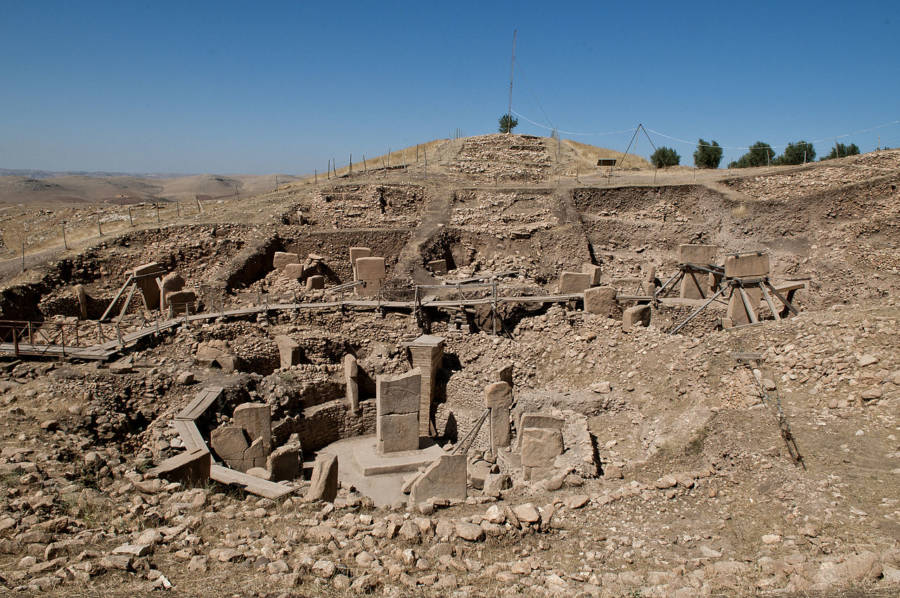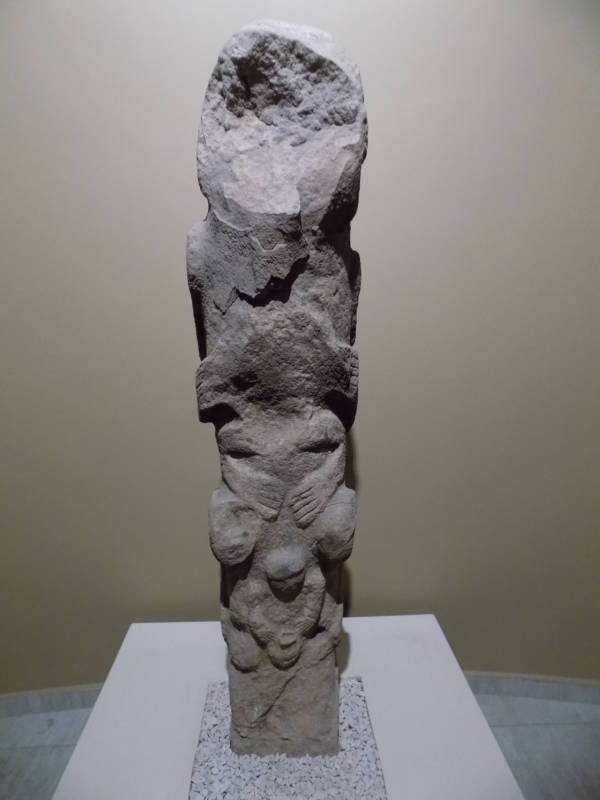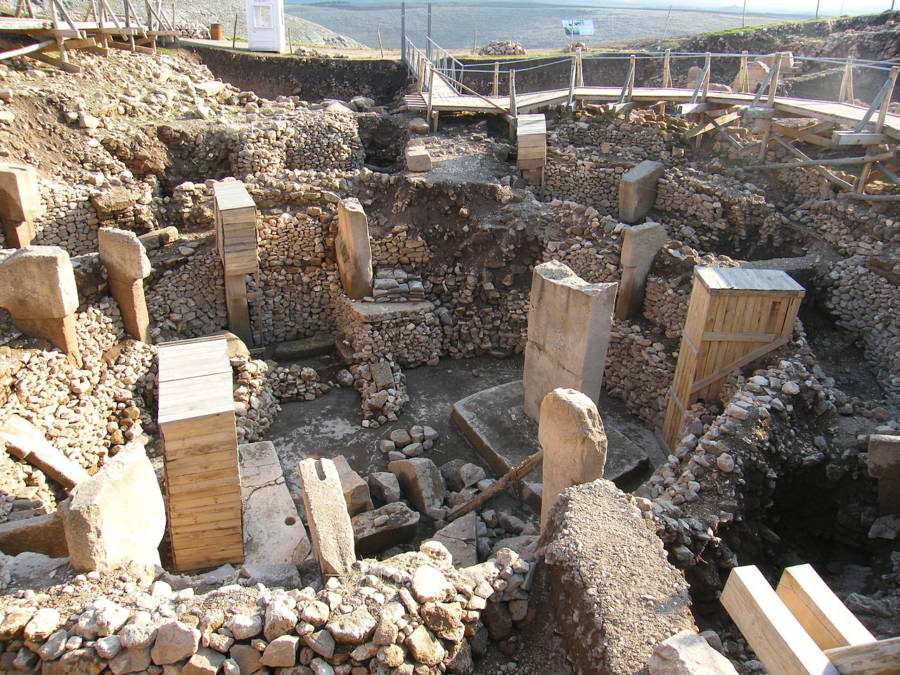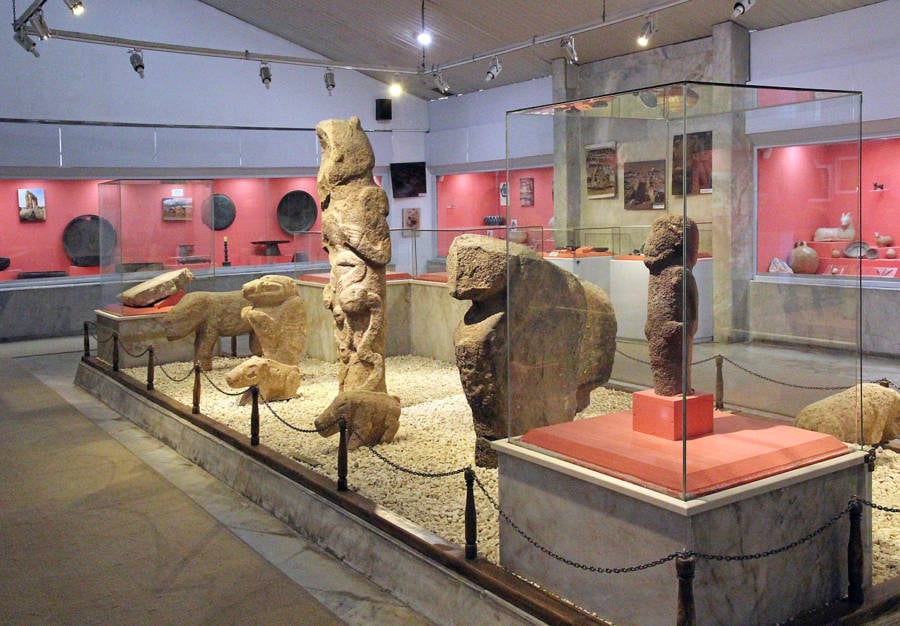"Gobekli changes everything." And it's not an
exaggeration: when Gobekli Tepe was uncovered in 1994, it changed how we
understand the rise of human civilizations.

Wikimedia CommonsThe Gobekli Tepe dig site. May 13, 2012.
“Gobekli changes everything,” says Ian Hodder, an anthropologist at Stanford University.
It’s not an exaggeration. When Gobekli Tepe was uncovered in 1994, it
changed everything we thought we knew about human history. Gobekli Tepe is a massive, ancient temple found in Turkey, built out
of pillars organized into great stone rings. The pillars are decorated
with intricate sculptures of lions, scorpions, and vultures, twisting
around their sides, but they’re more than just beautiful works of art.
They’re the foundations to a structure, holding upheaving blocks that,
some of which weight more than 10 tons.
The artwork and engineering is incredible. That anyone could have
lifted up 10-ton stones and placed them atop a foundation strong enough
to hold them in place is an incredible feat in any time.
But what makes Gobekli Tepe so unbelievable is that it was built in
10th millennia BC – more than 11,500 years ago – and is actually the
oldest temple in the world.
Just How Long Ago Was 9,500 BC?

Wikimedia CommonsAn intricately sculpted totem pole from Gobekli Tepe. March 11, 2017.
Let’s put that in perspective. Stonehenge was built in 3000 BC, and
the oldest signs of human writing were created in Sumer in 3,300 BC.
That means that Gobekli Tepe isn’t just older than written language.
More time passed from the construction of Gobekli Tepe to the invention
of the written word than from Sumer to today.Even agriculture didn’t exist yet – or, at least, certainly not in
that area. There are, admittedly, some small signs of people growing
crops before 9,500 BC, but it’s doubtful that there were any
full-fledged communities with farms.
The people who built Gobekli Tepe were what we’d call cavemen. They
were hunters and gatherers working with tools made out of stone. And
they managed to build something that should have been impossible.
Klaus Schmidt’s Discovery Of Gobekli Tepe

Wikimedia CommonsThe Gobekli Tepe Archaeological site. March 9, 2012.
The archaeologists who first found Gobekli Tepe in the 1960s didn’t
think it was anything more than a medieval graveyard. They had found a
hill with broken slabs of limestone and didn’t bother looking further,
sure there’d be nothing more than a few bones laid to rest a couple of
centuries before.
It wasn’t until 1994 that the truth came out. Klaus Schmidt, a German
archaeologist, visited the site and realized immediately that there was
something massive hidden underneath that hill. “Within a minute of
first seeing it, I knew I had two choices,” Schmidt would later say: “go
away and tell nobody, or spend the rest of my life working here.”He decided to stay, and he’s been working on the site ever since. It
was worth it. Radiocarbon dating has confirmed that this temple really
was built 11,500 years ago, making it easily one of the most significant
archaeological discoveries in recent history.
A Stone Age Temple

Wikimedia CommonsA close-up view of one of Gobekli Tepe’s pillars. September 6, 2011.It’s hard to say anything for sure about how a place as old as
Gobekli Tepe was used. Schmidt is convinced, though, that it was built
as a temple.
There are no cooking hearths, houses, trash pits, or farms to suggest
that anyone ever settled down and started a town around it. Instead, it
seems that the people who used it were constantly on the move. They
were nomadic hunters who couldn’t stay in one place for long.
“It’s a landmark,” says Jens Notroff,
an archaeologist who works on the site. “Back then people would have to
meet regularly to keep the gene pool fresh and exchange information…
It’s no accident they gathered there.”They would have massive feasts inside. That’s something we know for
sure because they left countless animal bones behind. The animals they
ate, though, were all wild animals like gazelle, deer, birds, and
aurochs. They were animals that were hunted and carried off to the site
for a meeting that must have held a deep, spiritual significance.
There’s a good chance they got drunk during these meetings, too.
Massive, stone jars were left behind at the temple site, big enough to
hold more than 40 gallons of liquid. There’s no way to know for sure but
the archaeologists suspect that liquid was an early type of beer.

Wikimedia CommonsA close-up of one of the pillars, depicting what’s believed to be an image of an ancient god. June 12, 2011.People came from incredible distances to visit Gobekli Tepe.
According to Schmidt, people from Israel and even as far as modern
Egypt would have made the pilgrimage up to Gobekli Tepe – a trip that,
if he’s right, would’ve required them to travel up to 1,500 kilometers.
For anyone to travel that far, it would’ve had to have been the
mandate of the gods. That’s part of the reason why the archaeological
team is convinced that this was an ancient temple and that the carvings
on the pillars are a glimpse into an ancient, Stone Age idea of the
gods.“I think here we are face to face with the earliest representation of
gods,” Schmidt says. “They have no eyes, no mouths, no faces. But they
have arms and they have hands. They are makers. In my opinion, the
people who carved them were asking themselves the biggest questions of
all. What is this universe? Why are we here?”
Gobekli Tepe: A Challenge To Human History

Wikimedia CommonsSculptures from Gobekli Tepe on display in a museum in Urfa, Turkey. May 13, 2012.This is more than just an old temple. It’s a discovery that forces us
to seriously rethink some of the biggest ideas about how human
civilization began.
Before, it was always assumed that civilization began with
agriculture. People settled into farming communities first, we believed,
and then worked together to build the massive temples and buildings
that would make up humanity’s first cities.
Gobekli Tepe, though, was built 500 years before
its people built their first farms. That might mean that our whole
concept of how human civilization began needs to be rethought. Here, at
least, people seem to have congregated and worked together to build a
temple before even making their first farms.
Perhaps culture came before agriculture. That’s what some people
think Gobekli Tempe represents. The force that gave birth to
civilization wasn’t necessity or survival – it was something spiritual.



No comments:
Post a Comment